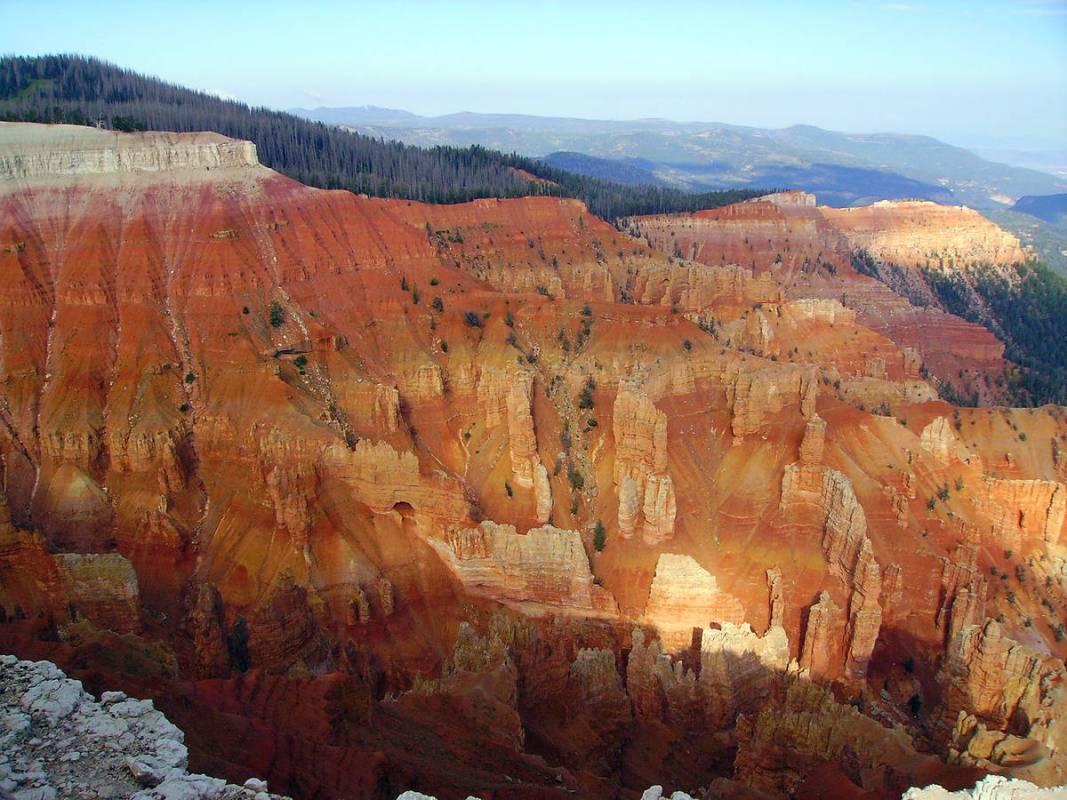
Craving clean air, cool temperatures or spectacular scenery? You can have all three together at Cedar Breaks National Monument in Utah.
Cedar Breaks stands on the west-facing escarpment of the Markagunt Plateau, at an elevation exceeding 10,000 feet. Besides cool summer temperatures, the park is best known for its natural amphitheater, three miles wide and 2,000 feet deep.
This wonder is composed of limestone that has been uplifted over millions of years; its red, pink, purple and yellow colors are from the oxidized iron and manganese. Erosion by rain, ice and wind has carved the stone into hoodoos, arches, spires, windows and other natural shapes.
Besides geologic features, the park is a joy to visit for its vegetation. You will find grassy meadows, aspen groves, bristlecone pine and sub-alpine fir. Cedar Breaks also has one of the finest midsummer wildflower displays to be seen anywhere, and is home to several hundred flower species.
Depending on the weather, wildflower season usually gets started in late June with mountain bluebell, cushion phlox and lavender fleabane. In early July broad meadows are often carpeted with wildflowers. Early July brings Mountain Meadow groundsel and Markagunt and Rydberg’s penstemons. Later in the month look for little sunflower, tower gentian, lanceleaf goldenweed and meadow gentian. Along the main roads and among the conifer trees, there is often an abundance of lupine, scarlet paintbrush, larkspur and Colorado columbine as well.
The reasons for the good wildflower show each year are that the Markagunt Plateau has great sedimentary soil and gets plenty of monsoon moisture. In summer, moist air from the Pacific is drawn inland. Hot air, which holds more moisture, first rises above the Mojave Desert and then up to the mountains, here at 10,000 feet in elevation. It cools and loses its holding capacity, causing condensation, clouds and monsoon rains. The rains often take place between 10-11 a.m. daily. It is also very common to have afternoon thunderstorms.
The park is once again open to visitors; its Sunset Trail and all the overlooks are open. Other trails will open once they are free of snow and mud.
Point Supreme Campground opens Friday and is expected to remain open through Sept. 19. This campground has restrooms with warm water and flush toilets. Campsites have a fire ring, picnic table and tent pad. Reservations can be made at https://www.recreation.gov.
Daily high temperatures in late June are usually in the 70s and 80s with lows in the 40s and 50s. Be aware though, at this elevation, it can snow any month of the year, so pack accordingly.
The park’s entrance fee is $10 per person (age 16 or older) and can be paid at the visitor center (Supreme Overlook area). It’s currently open from 9 a.m. to 6 p.m. This visitor center is a historic log cabin built by the Civilian Conservation Corps in 1937, directly on the rim of the amphitheater. To reach the cabin requires walking about 100 yards from the parking area.
For more information call the park’s visitor center at 435-586-0787.
For changes and current operating status at Cedar Breaks National Monument, due to COVID-19, use https://www.nps.gov/cebr/index.htm. You should do both before leaving home because cell service is unreliable in the park.